Wrapping Up My Solo Time
by ANN Managing Editor Rob Finfrock
There are certainly worse ways to spend a Saturday, I
thought to myself as I lazily banked the Gobosh over the St. Johns
River at 1,500 feet, using a stationary pontoon boat near the bank
as a ground reference point.
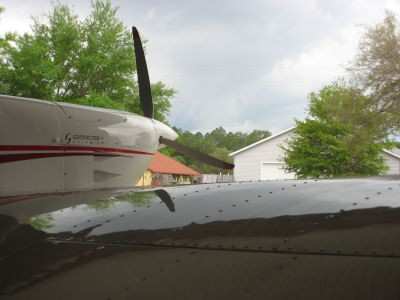
Still buoyed from passing the oral exam the day before, my
mandate for the morning was to take the 700S up for awhile, to take
as big a chunk out of the 2.3 hours solo time I still had to burn
off as I could. To do so would require me to skirt under a low, but
constant, 2,000' broken cloud ceiling, and to deal with some fairly
strong wind gusts... both in the air, and near the ground.
The conditions weren't optimal for a solo flight, but they
weren't so bad either. My instructor, Jim Crone, and I had
discussed the weather before I took off, and he'd allayed my
concerns about the clouds and wind.
"Aren't those some pretty strong wind gusts?" I'd asked
worriedly.
"Nah," Jim had replied, seemingly nonchalant though I knew he
had considered the weather carefully before answering. "Your winds
are directly out of the southwest, and though they're pretty brisk
they're not gusty. You'll get some good crosswind practice."
"And the clouds?" I asked. One of my biggest in-flight fears is
going IMC, and losing my visual reference to the ground and
horizon.
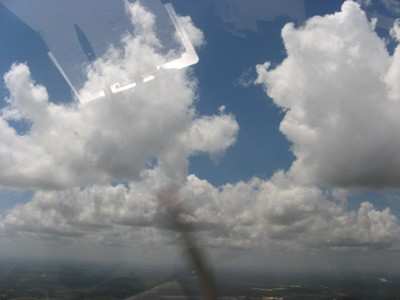
"Two-thousand feet broken," he replied, echoing the information
I'd received in an abbreviated briefing from Flight Service about
10 minutes earlier. "And it's forecast to lift to 3,000 or better
in the next couple hours.
"I'd also bet anything once you get up in the air, you'll still
be able to see the coastline from here. It's actually a really
clear day for Florida, no haze," Jim continued. "And the forecast
says the storms won't move in until early afternoon."
Still, it was with some apprehension that I preflighted N702GB,
taxied out for departure, and took off just before 11 am. I knew
that conditions were clear over Haller, and if they weren't as
clear elsewhere I figured I could do a lap of the pattern and land,
staying in sight of the airstrip at all times. Fortunately, Jim's
prediction about the skies was entirely accurate: upon climbing out
to 1,000 feet, I could already see the faint line on the horizon
separating land from the Atlantic Ocean.
*****
My first task was to land at Palatka, to fill up. There were two
other planes in the pattern, a Seminole shooting touch and goes on
runway 17 and a Cirrus behind it to land. I called out on the CTAF,
and announced I'd enter the pattern on the left downwind behind the
Cirrus.
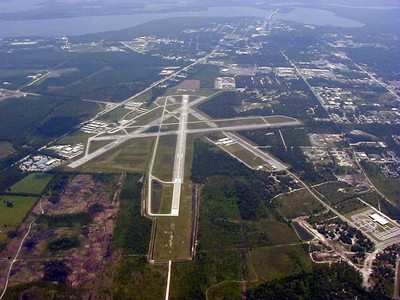
"Wind's blowing pretty good from about 200," the pilot in the
Seminole -- probably the instructor -- called out. "It's a great
day for crosswind practice!"
Yeah, great, I thought. Without a weather station at
28J, I'd been unable to get the winds there... but
extrapolating from the information available out of Gainesville to
the west, and St. Augustine to the northeast, the wind was likely
blowing at around 15 knots... resulting in a 30-degree
crosswind component well within the 700S's limits.
Whether it's within your limits is another matter. But
as I entered the downwind leg, a calming sense came over me. I
reminded myself that I'd been landing in crosswinds on nearly all
my lessons over the past 12 days, and they'd been largely a
non-issue once I adapted to the 700S's landing characteristics. The
transition from a crab on final to a slip over the numbers had
largely become second nature. Yeah, the winds are a bit
stronger now, but the basics are the same.
Besides, if things go south you can always go around and
head back to Haller, where the trees block out most of the
crosswind anyway. But that wasn't a serious option, not yet
anyway. I wanted to fly this morning... and I wanted to prove to
myself that, yes, I was a pilot.
The wind required some interesting crab angles in the pattern to
stay on course. I remembered to turn final a hair later than usual,
to compensate for the wind. The result was a ground track that put
me directly on the extended centerline to the runway, with the
plane's nose canted to the right. "Yep, looks like around 30
degrees," I said to myself.
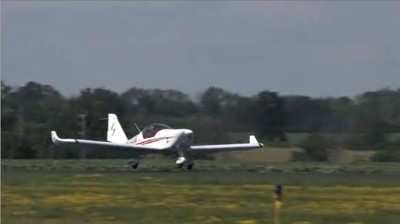
I carried a bit of power against the wind, and set half-flaps.
That put me on a shallower-than-normal final over the displaced
threshold for 17, but the picture outside the canopy looked right.
I pulled the throttle over the numbers at 55 knots, and kicked in
some left rudder to bring the Gobosh's nose in line with the
centerline, keeping right aileron in against the wind.
Chirp. I heard the right maingear touch down a
half-second before I felt it... and the left wheel kissed the
runway a second later. I held the nose off the ground with a bit of
power, playing with the rudder to keep the nose centered. The
result was probably my smoothest touchdown ever in the Gobosh, and
I briefly wished Jim had been with me to witness it.
I turned off the active at the intersecting runway 9/27 -- I
even remembered to call out that I was doing so -- and I taxied
over to the fuel pumps. The Gobosh took 14 gallons on the nose, in
an 18.5 gallon tank. Even with the thrifty Rotax, it was probably
better that I'd managed to land, rather than fly back to
Haller.
After stretching my legs for a bit, I mounted up and took off on
17, exiting on the downwind to the north. I bid the Seminole
farewell with a quick "have fun!" call over the CTAF.
"You too!" the same pilot as before replied. "Sharp little
plane, by the way."
Yes it is, I thought, patting the Gobosh's IP combing,
in what had become a familiar affectation since my first solo.
As I flew north on a general course back towards Haller, I
reflected on how my attitude and affection for the plane had
shifted somewhat since I'd started flying.
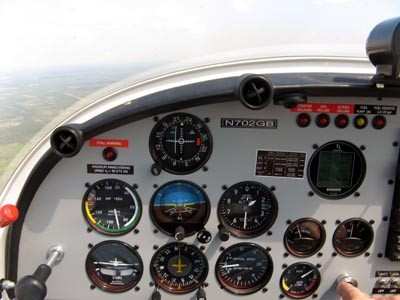
While I'd been grateful from the start for the opportunity to
fly, and appreciative of the 700's cockpit room and build quality
-- far better in both respects than in some jets I've flown on
recently -- I admit it took me awhile to go ga-ga over the Gobosh
(yes, the alliteration was intentional.) As I've written before, I
had problems at the start adapting to some aspects of the plane's
performance,
especially the need for a healthy dose of right
rudder.
I'll also admit -- now -- that I even resented the plane a
little bit... because darn it, it wasn't making me look good.
Me, the ace pilot, with over 70 hours in his logbook but still
no rating.
I can't pinpoint the exact moment when my change in
perception happened. It probably started sometime around
the time I took the FAA written, and definitely by the time
Jim and I flew back from Punta Gorda. But once I finally figured
out how to fly the Gobosh -- instead of trying to fly it like the
previous aircraft I'd flown -- my attitude changed. I felt in tune
with the plane, and it hadn't steered me wrong since.
And now, as I flew north over Highway 17 -- having just
performed a very nice crosswind landing I'd never dared dream of
doing two weeks before -- I realized how much genuine affinity I
now had for the little plane I was flying. I felt like
I'd accomplished something, in learning how to fly it
properly.
That's it... I'd learned. Which was kind of the point
of all this, after all.
Trimming the plane to hold 1,500 feet, more or less -- the wind
conspired to bounce me and the plane off that exact altitude -- I
contemplated my next move. A glance at the Hobbs showed I'd only
burned off 0.4 hours, including the stop at Palatka. After
glancing at my unofficial checklist for the flight, I banked left,
away from the river, to practice steep turns, "S" turns and turns
about a point -- all maneuvers I've had some difficulty with
performing.
Of course, the wind made these maneuvers all the more
challenging... but I figured this was actually a plus, as it gave
me yet another obstacle to work against... and with some practice,
I was able to hold the required steep angles and altitude during
each maneuver, fighting with the wind at every step.
That took about a half-hour or so (another 0.4 on the Hobbs)
leaving me with a decision to make. Despite the fun I was having,
part of me wanted to land back at Haller, since it was rather bumpy
at altitude (winds again) and the low cloud deck was still making
me a little nervous... but given the task at hand, I turned and
headed southeast across the St. Johns River, to eat up some more
flight time. Just for the fun of it, I slowed to 65 knots, extended
one notch of flaps, and trimmed for slow flight.
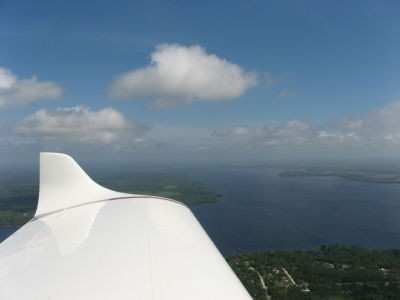
That turned out to be a good decision... as the air smoothed out
considerably across the river, allowing me to relax a bit, not
having to fight the flight controls. I lazed across the sky for
about 15 minutes, occasionally practicing more steep turns... but
generally flying level and snapping a few pictures.
*****
By 12:15 pm, the Hobbs meter showed I'd been flying for 1.3
hours... and, truth be known, I was now kind of bored, as I'd
accomplished everything I set out to do on my checklist except for
stalls (due to the low clouds that kept me from climbing to the
required 3,000 feet AGL.) I was also a little thirsty... so I
decided to head back towards Palatka, land, and grab a bottled
water.
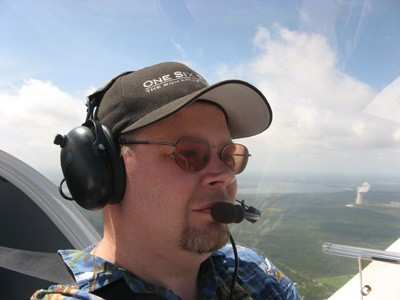
I was glad I did... as it provided me with two more good
lessons. The first one came about as I was over the treeline, once
again on short final to land on runway 17. Again I was fighting a
stiff headwind... but it was more-or-less straight down the runway,
so I didn't need a great a crab angle to stay on track as before.
Though my airspeed was pegged at 65 knots, my ground speed was a
lot slower. It felt like I was crawling along the ground, fighting
my way to the runway.
And then, suddenly, I wasn't. I looked down, and my airspeed had
dropped to nearly 50. Wind shear! I slammed in the
throttle and lowered the nose ever-so-slightly, and recovered
the needed knots before the plane began to drop further. I think I
caught it about as quick as I could have, but it still didn't seem
fast enough; had I not been paying attention, the plane would have
possibly come close to stalling -- within about 100 feet of the
ground.
Things smoothed out after that, though my adrenaline was
pumping. The 20-knot headwind helped me make a fine short-field
landing, and I taxied over to the small terminal/FBO on the field.
Since I'd already gassed up once, I didn't need fuel. After tying
the wings down -- the wind had tried to push the plane forward when
I'd opened the canopy to climb out -- I walked in, greeted Dave,
the counterperson, and made a beeline for the Coke machine for a
Dasani.
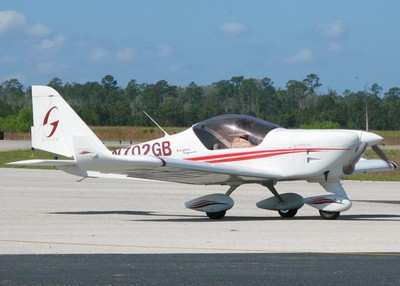
"In from Haller?" Dave asked me. Jim and I had been a
familiar sight at Larkin Field over the past two weeks.
"Yep, burning off solo time," I replied. "I passed my oral
exam!"
We chatted a little more, then Dave asked "have you seen the
latest weather?"
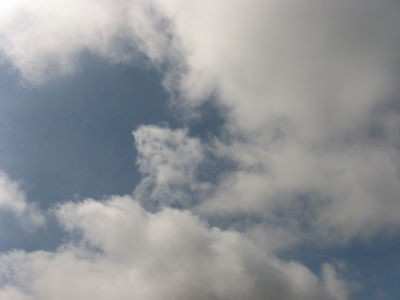
I replied in the negative; I hadn't been near a computer or a
phone in nearly two hours. I had been keeping an eye on the clouds,
of course, and nothing too threatening had popped up.
Dave's eyebrows perked up, and he motioned over to the weather
computer. "Check it out. There's a major cell over Gainesville
right now."
I looked. Sure enough, a line of green -- with some ominous
fingers of orange -- was forming directly over Gainesville, about
30 miles to the west. It seemed to be moving relatively slowly
towards the east; the last echo was recorded 10 minutes before,
according to the time stamp on the image.
Decision time. I'd planned to burn off at least another
45 minutes in the air before I returned to base... but the weather
forecast altered that plan. Conversely, the weather was still far
enough away that I didn't need to wait it out at Palatka; if I took
off in the next 10 minutes or so, the 20-minute flight back to the
airstrip would put me on the ground in plenty of time before the
clouds moved in.
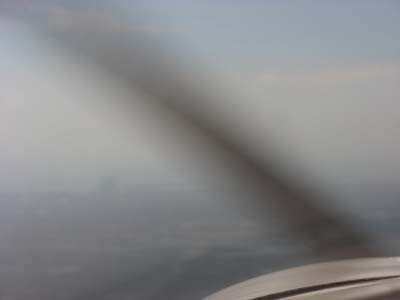
"I'd better head out," I told Dave. "Better safe than
sorry."
He nodded. "Good luck on your checkride!"
Though there wasn't a real reason for me to rush things -- the
skies to the west were still clear -- I still worked through the
checklist in record time, not missing a single item (it helped that
the checklist is pretty simple, of course.) The Gobosh's wheels
were off the runway within seven minutes after I started the
engine.
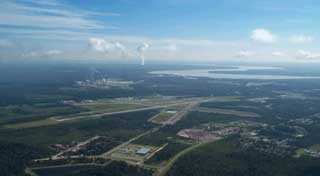
It was a bumpy ride back to Haller. The Gobosh and I got bounced
around pretty good from the moment I turned downwind to exit the
pattern to the north. And sure enough, the clouds appeared darker
to the west once I climbed up to 1,500 feet... but they still were
well off in the distance, and I was moving at least three times
faster than they were. I would have much preferred clear, calm
skies... but everything was well within limits, the clouds over
head were at least 1,500 feet above me, and I still had easily 15
miles visibility.
The winds were on my mind as I entered the pattern at Haller.
From downwind, I could see the windsock sticking straight out,
favoring landing to the south, as expected. In fact, the wind
seemed to be blowing straight down the runway.
Poy-fect.
For as much bumping around that was going on as I descended --
wind currents blowing off the trees causing updrafts -- the
approach was very calm, and routine. I'd planned for some burbles
over the trees at the end of the runway, but I figured things would
calm down after I was below the treeline. Which is exactly how it
played out.
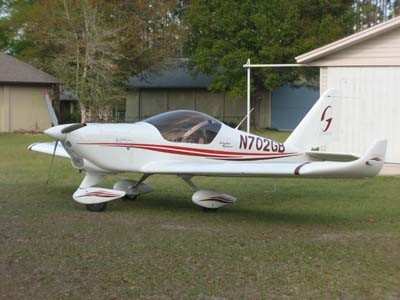
As I wheeled around and back-taxied to the end of the runway, a
strange melancholy came over me. This wouldn't be the last time I'd
fly the Gobosh by myself -- thanks to the weather I still had .6
hours solo time to go, that I'd need to burn off sometime during
Sun 'N Fun -- but this would probably be the last time I'd land it
at Haller. Jim Crone planned to fly back to Punta Gorda for the
weekend, if weather permitted; the next time I'd see him, and the
plane, would be down in Lakeland.
I looked at the trees I'd just flown over,
the same ones that had seemed so tall 12 days
before. They didn't seem quite as big now.
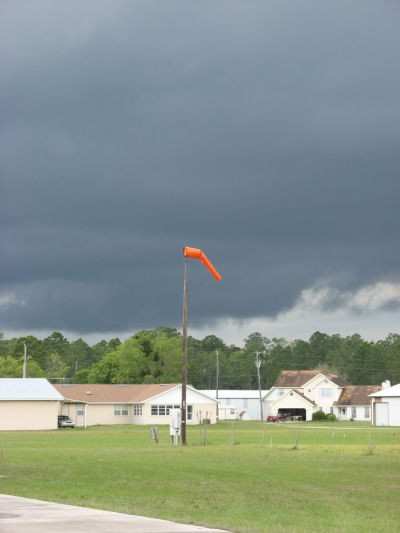
By the way, the storms (above) moved in 45 minutes
after I landed. I was quite relieved to be on the ground.
Coming Soon: The Last Chapter, Time For The
Checkride!
 ANN's Daily Aero-Linx (04.16.24)
ANN's Daily Aero-Linx (04.16.24) Aero-News: Quote of the Day (04.16.24)
Aero-News: Quote of the Day (04.16.24) Airborne 04.10.24: SnF24!, A50 Heritage Reveal, HeliCycle!, Montaer MC-01
Airborne 04.10.24: SnF24!, A50 Heritage Reveal, HeliCycle!, Montaer MC-01 Airborne 04.12.24: SnF24!, G100UL Is Here, Holy Micro, Plane Tags
Airborne 04.12.24: SnF24!, G100UL Is Here, Holy Micro, Plane Tags Airborne-Flight Training 04.17.24: Feds Need Controllers, Spirit Delay, Redbird
Airborne-Flight Training 04.17.24: Feds Need Controllers, Spirit Delay, Redbird















